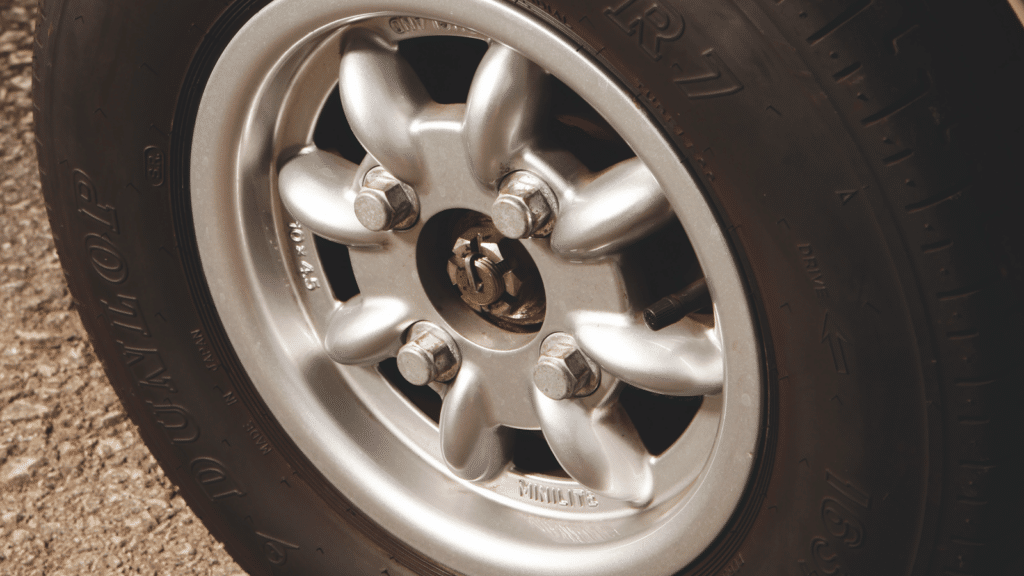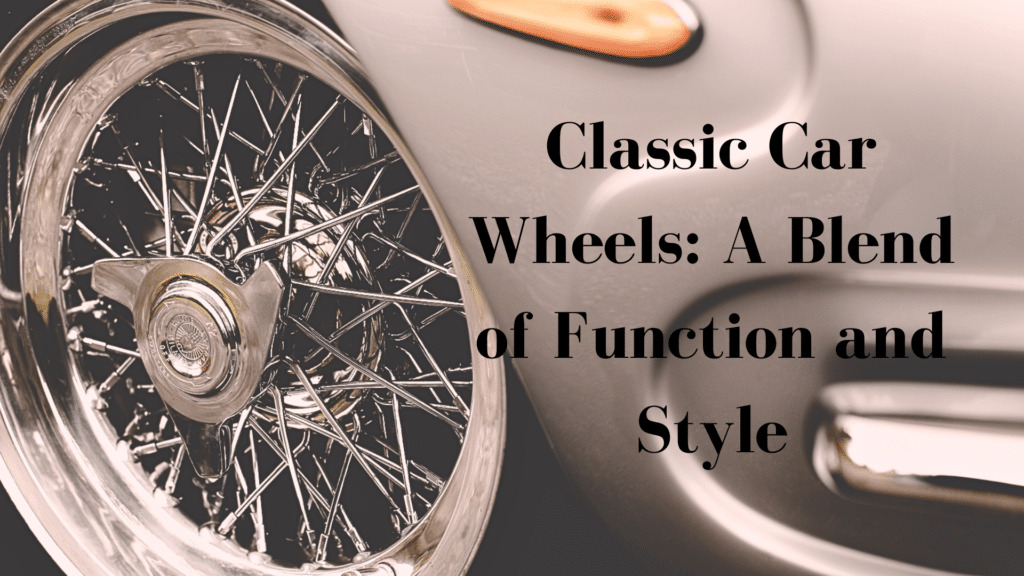The wheels on classic cars tell stories.
From the gleaming chrome spokes of a 1957 Chevrolet to the bold steel rims of a 1969 Mustang, each wheel design captures a moment in automotive history.
Many collectors know that finding original wheels for vintage cars can be challenging.
Rust, damage, and scarcity make finding the right set challenging.
But the hunt is worth it—original wheels boost a classic car’s value and keep its history alive.
In this guide, I’ll show you:
- Tips for finding rare wheel designs
- Ways to maintain and restore vintage wheels
- Common problems and their fixes
With 25 years of experience restoring vintage wheels, I’ll help you understand what makes them special and how to find the perfect set for your classic car.
Let’s look at the basics every collector should know.
What Makes Classic Car Wheels Unique?

Old car wheels weren’t just made – they were crafted.
I’ve spent years studying these wheels, and the details still amaze me. Let me show you why they stand out.
Hand-finished details matter.
In the past, workers polished each spoke by hand, and the chrome had a visible depth.
Today’s mass-produced wheels can’t match this careful work.
Many classic wheels used real steel and chrome – not the plastic covers we often see now.
You’ll notice the weight difference right away.
Pick up an original 1960s wheel, and you’ll feel its solid build.
Here’s what sets genuine classic wheels apart:
- Thicker metal that resists bending
- Hand-fitted center caps that click perfectly
- True chrome finish that runs deep into the metal
They tell stories through their design.
Each wheel style matched its era.
The simple steel wheels of the 1940s showed post-war practicality.
The flashy fins and spokes of the 1950s captured the space age spirit.
Modern copies might look similar, but they lack key details.
When you compare an original wheel to a reproduction, you’ll see differences in the parts’ curves, finish, and fit.
These wheels are more than just car parts—they’re history pieces showing how cars have changed over time.
Getting the right wheels matters so much to collectors who want to keep these stories alive.
Exploring the Types of Classic Car Wheels
Let me describe the main types of classic car wheels I’ve worked with.
Each type has its charm and purpose.
Wire Wheels
You might’ve seen these on old British sports cars.
They use thin metal spokes that connect the rim to the center.
I love how the light plays through the spokes.
They take time to clean, but the look is worth it. Many car owners choose these for shows.
Steel Wheels
These are the workhorses of classic cars.
I’ve found them on everything from old Fords to Chevrolets.
Here’s what makes them special:
- They rarely bend out of shape
- Paint sticks well to them
- They’re easy to fix
- You can find parts for them
Alloy Wheels
Sports cars from the 1960s and 1970s often had lighter wheels.
These wheels helped cars go faster and stop better.
While they cost more than steel wheels, they improved handling on the road.
Wheel Covers and Hubcaps
Many classic cars used plain steel wheels with fancy covers. I’ve seen some beautiful designs:
- Moon discs for hot rods
- Spinner caps from 1950s cars
- Starburst patterns from luxury models
- Simple chrome caps that show the car’s logo
Each type suits different cars and needs.
You’ll want to match your wheels to your car’s year and style.
Remember – the right wheels make the whole car look better.
The Evolution of Classic Car Wheel Designs
I’ve watched wheel designs change over the decades.
Let me show you how they went from basic to beautiful.
The Early Days (1920s-1930s)
Cars first rolled on simple wooden wheels with metal bands.
They worked, but that was about it.
Then came steel wheels—black, basic, and strong.
Car makers focused on making wheels that could handle rough roads.
Post-War Changes (1940s-1950s)
This is when things got interesting. I’ve seen how cars started showing off:
- White wall tires became popular
- Chrome trim made wheels shine
- Wheel covers got more detailed
- The colors matched the car paint
The Speed Era (1960s)
Race cars changed everything. You started seeing:
- Wider wheels for better grip
- Lighter materials for speed
- Bigger sizes all around
- Special patterns for cooling brakes
New Materials Take Over (1970s)
I remember when alloy wheels became common.
They mixed good looks with better performance. Car makers tried new things:
- Different metal mixes
- New ways to shape wheels
- Fresh paint choices
- Bigger brake space
The best part?
Each era left us with wheels that still look good today.
That’s why collectors search for wheels that match their car’s era—they help tell the whole story.
Popular Vehicle Models that Use Classic Car Wheels
Let me share some famous cars I’ve worked on and their special wheels.
Each one shows how wheels help make a car memorable.
Ford Mustang (1964-1973)
The early Mustangs had wheels that stood out.
I’ve restored many sets of their styled steel wheels with their five-spoke pattern.
You can spot a real Mustang just by looking at its wheels.
Chevrolet Corvette (1953-1967)
These sports cars changed wheel styles often:
- 1953: Clean steel wheels with full covers
- 1957: Added small fins to the covers
- 1963: Knocked-off aluminum wheels
- 1967: Rally wheels with bright trim rings
Jaguar E-Type (1961-1974)
British cars loved their wire wheels, and the E-Type’s wheels needed special care.
You might spend hours cleaning each spoke, but there’s nothing like it when the sun hits them just right.
Volkswagen Beetle (1938-1979)
Simple but special – that’s what made Beetle wheels great.
I’ve seen how their basic steel wheels with chrome hubcaps became a style all their own.
You can find these wheels everywhere, but the original ones still catch the eye.
Plymouth Road Runner (1968-1970)
Those Mopar rally wheels meant business.
Wide, strong, and ready for speed.
When you see them on the street, you know what’s coming.
What Made These Wheels Special
Each car company tried to make wheels that would:
- Match their car’s style
- Show their brand’s quality
- Stand out from other makers
- Last for many years
These wheels weren’t just parts – they helped make these cars famous.
That’s why finding original wheels matters so much to collectors today.
How Classic Car Wheels Stand out From Modern Wheels
I’ve worked with both old and new car wheels.
Let me show you the big differences I’ve noticed over my years in the shop.
Built to Last
Classic wheels were made thick and strong.
When you hold one, you’ll feel the extra weight right away.
Modern wheels often use thinner metal to save weight.
But those old wheels?
They could take a beating and keep going.
Simple but Special
Here’s what makes old wheels different:
- No fancy computer designs
- Hand-finished surfaces
- It’s real metal all the way through
- Repairs you can do at home
Materials Matter
Today’s wheels use lots of aluminum and plastic. But classic wheels kept it basic:
- Pure steel construction
- Real chrome plating
- Brass fittings
- Zinc-coated parts
Easy to Fix
I love how simple it is to fix classic wheels. You can:
- Hammer out dents
- Replace broken parts
- Replate the chrome
- Fix them without special tools
Looks vs. Performance
Modern wheels focus on:
- Saving weight
- Better airflow
- Computer testing
- Complex shapes
Classic wheels aim for:
- Clean lines
- Simple shapes
- Strong builds
- Timeless style
Tips for Selecting Classic Car Wheels
After 25 years of helping collectors find the right wheels, I have learned some tips to save you time and money.
1. Know Your Car’s History
If you have your car’s build sheet, pull it out and write down the wheel size, bolt pattern, and offset.
These numbers matter; getting them wrong means the wheels won’t fit.
2. Check Every Inch
Before buying old wheels, look for:
- Cracks near bolt holes
- Bent rims
- Rust spots
- Missing pieces
3. Match the Time Period
Your 1965 car should have 1965-style wheels.
I’ve seen good cars spoiled by wheels from the wrong year.
Small details make a big difference.
4. Real vs. Copy
Original wheels cost more than copies.
Here’s how to tell them apart:
- Check for maker’s marks
- Look at the metal quality
- Compare the weight
- Study the finish
5. Buy from Good Sources
- Known collectors
- Classic car shows
- Car club members
- Certified dealers
6. Test the Fit
Measure twice, buy once.
Bad fit means:
- Wheels that rub
- Poor handling
- Unsafe driving
- Wasted money
7. Fix or Replace?
Some damage can be fixed.
But badly bent or cracked wheels need replacing.
A good repair shop can tell you what’s safe.
8. Plan Your Spending
Good wheels aren’t cheap. Set aside money for:
- Purchase price
- Shipping costs
- Needed repairs
- New tires
9. Ask Other Collectors
Join online groups.
Read old posts.
Most collectors love sharing what they know.
Their tips can help you avoid mistakes.
10. Watch the Market
Keep track of wheel prices.
Some styles increase in value, while others remain the same.
Smart buyers know the difference.
Remember: good wheels make the car better, and bad wheels make everything worse. Take your time and choose well.
Common Mistakes when Choosing Classic Car Wheels
1. Not Checking Original Specs
Too many buyers guess what they need.
I’ve watched people waste money on wrong-sized wheels.
Always find out:
- Original wheel width
- Correct bolt patterns
- Factory offset numbers
- Standard finish type
2. Picking Looks Over Use
Pretty wheels catch eyes.
But they need to work well, too.
I’ve seen beautiful wheels that:
- Don’t clear the brakes
- Make the car handle poorly
- Rub against fenders
- Can’t hold proper tire sizes
3. Missing Problem Signs
Small problems become big ones.
Look closely at:
- Hairline cracks
- Uneven wear spots
- Loose chrome
- Old repairs
4. Not Thinking About the Whole Car
Your wheels must work with:
- Your brake setup
- The suspension type
- Your driving style
- Road conditions
5. Taking Sellers at Their Word
“Original” doesn’t always mean original.
I’ve seen many fake wheels sold as real ones.
- Ask for close-up photos
- Check serial numbers
- Look up maker’s marks
- Get expert opinions
6. Forgetting About Care
Different wheels need different care.
Think about:
- Cleaning time
- Parts costs
- Special tools needed
- Regular upkeep
Each mistake can cost you money and time.
But now you know what to watch for, you can make better choices.
Classic Car Wheel Brands Worth Considering
I’ve installed thousands of wheels over the years.
These brands stand out for their quality and history.
Borrani
Italian craftsmanship at its best.
I’ve put these wire wheels on many high-end cars.
They cost more, but the quality shows.
Each wheel takes hours to build by hand.
American Racing
These wheels helped create the muscle car look.
What I like about them:
- Strong enough for big engines
- Clean, simple styles
- Good parts supply
- Fair prices
Dayton Wire Wheels
They’ve made wheels since 1916.
I trust their wire wheels because:
- The spokes stay tight
- Chrome lasts longer
- Repairs are simple
- They keep making parts
Cragar
Hot rod builders love these wheels.
You’ll see them on street rods everywhere.
Their S/S wheel changed how hot rods looked.
Even now, people want the classic Cragar style.
Halibrand
Race cars used these wheels to win.
They’re light but strong.
Finding real ones takes time, but they’re worth it.
Many racing teams picked these wheels first.
Minilite
British sports cars often wore these wheels.
They’re simple but good-looking. I like how they:
- Fit many cars
- Stay round and true
- Clean up easily
- Look right at home
Enkei
They mix old and new ideas well. You get:
- Modern safety standards
- Classic wheel looks
- Good value
- Easy maintenance
Each brand has its place.
Pick the one that fits your car’s style and your needs.
Remember – good brands last longer and hold their value better.
Conclusion
Quality wheels make all the difference in classic cars.
After 25 years of working with these beauties, I still get excited when I find an original set in good shape.
Your wheels tell people what your car is about.
Clean, true rims with the right finish show you care about doing things right. They also help preserve our car history.
Start small. Learn what makes your car special. Join a local car club.
Most collectors love sharing their knowledge.
Remember: good wheels aren’t just parts but pieces of car history. Take time to find the right ones, fix them well, and keep them clean. Your classic car deserves that care, and future collectors will thank you.
Need help getting started? Drop a comment below. Let’s talk about your classic car wheel project.
Frequently Asked Questions
What’s the Best Way to Store Classic Car Wheels?
Keep them dry, off the ground, and away from sunlight.
To prevent flat spots, use wheel bags and tire cradles.
Can I Use Classic Wheels for Daily Driving?
It’s possible but not recommended.
Old wheels might not handle modern road conditions well.
Consider replica wheels for regular use.
How Often Should I Clean Classic Car Wheels?
Clean them monthly with mild soap and water.
Apply wheel wax every three months.
Check for damage during each cleaning.


